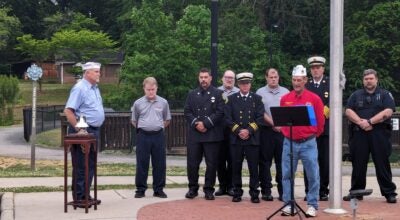Keeping World War II in focus
Published 12:00 am Monday, December 7, 2009
By Shavonne Potts
spotts@salisburypost.com
When Ray Simpson was just 14, he sat at his grandparents home in Kannapolis listening to the radio.
The announcer didn’t talk about the latest movie at the drive-in, but said some six or so hours prior, Japanese bombs rained on an American naval base at Pearl Harbor in Hawaii. It was Dec. 7, 1941.
“It was a Sunday afternoon,” Simpson recalled.
At that age, he didn’t completely understand the assault, but he knew enough to know what it meant. “It was going to be the beginning of World War II.”
“It didn’t quite hit me as to what it was going to develop into, but my grandparents said to me, ‘We are going to be in a big war,’ ” Simpson said.
Indeed, the surprise attack brought the United States into World War II.
Shortly after the declaration of war, it became harder to obtain common items, he recalled.
On Dec. 15, 1941, sales of automobile tires were halted, and by February 1942, companies stopped making automobiles.
Instead, the rubber was used to make tires for vehicles for military use.
Later on, sugar, gas, rubber boots, fuel oil, coffee and rubber bands were rationed.
“These materials were used for war. The reason they quit selling tires was because they got the raw rubber from a Japanese island,” Simpson said.
His grandfather Addy “Pop” Antley was a sales rep for aluminum wash tubs. He was laid off when all of the aluminum went toward the war effort.
Antley was appointed to the Office of Price Administration (OPA), which was established in 1941 under Leon Henderson to administer price controls. Rationing boards were created, and volunteers helped to monitor food, clothing and gas.
People were given war ration books. The books contained coupons or vouchers for items such as fuel oil, coffee or sugar.
“It affected everybody, some more than others depending on the size of the family,” he said.
It would be five years later that a 19-year-old Simpson would serve in the Army Signal Corps as a war photographer. Simpson took pictures of soldiers, planes, passports and the ruins of the aftermath.
The Signal Corps managed communications that now include military intelligence.
Simpson served for a short time, and over the years, he and his wife, Betty, created a scrapbook recounting his time in service. The couple have been scrapbooking for 57 years and have thousands of pictures in more than 50 books.
The war scrapbook begins on Jan. 21, 1946, with his draft notice and ends March 5, 1947 with his discharge papers.
Ray gathered the photos and other memorabilia, and Betty typed in the captions.
“I had always kept things. I didn’t know what I was going to do,” he said.
He managed to keep things here and there and made a place for them in his scrapbook.
“I got the whole works,” he said joking.
The books serve not only as a reminder of his travels but are like a time machine.
“I can go back through the books, and it’s like going back again. I can sit down and relive what I did at that time,” he said.
He began in the service at age 18 and turned 19 that October.
The war that had begun with the attack on Pearl Harbor ended with the surrender of Germany on May 8, 1945, and Japan on Sept. 2.
“President Franklin Roosevelt died 25 days before the end of the war,” he said.
Simpson went on training maneuvers in Virginia at Fort AP Hill for eight weeks. During a training session, the soldiers had rounds fired over their heads so they’d know what it felt like.
A bullet barely missed Simpson’s head. It zipped past his right ear and lodged in the dirt wall inside the trench.
He dug it out. It’s now affixed to a page in his scrapbook.
In April 1946, Simpson received the letters and documents saying he’d be going overseas.
He also went to Camp Kilmer in New Jersey. He had some time on leave and stayed with an aunt and uncle while in New Jersey.
In 1946, he went to a game at Yankee Stadium. He bought a program for 10 cents that included a players’ roster with names like Joe DiMaggio and Joe Page written on it.
He soon boarded a ship to France. His eventual destination was Germany. The 19-year-old then weighed about 120 pounds. A few guys gave him a hard time, declaring he’d be the first to get seasick because he was a “runt.”
Later, when Simpson inquired about how those same “husky” guys were doing, they were in their cabins, sick.
Simpson still has the seasick pills all of the men received before boarding. His are still sealed in the original silver foil-like packaging.
In July 1946, it took Simpson three days to leave France and reach Marburg, Germany. When he got to Germany he was told to take the train ticket they’d provided and ride to Berlin.
He was sent to Frankfurt.
“They said I wasn’t supposed to be there,” he said.
He didn’t have his documents to prove where he was supposed to report.
The United States, France, England and Russia had agreed to split occupied Germany in June 1945.
Simpson had to sneak back into parts of Germany. He rode in the back of a supply truck, hidden underneath a tarp.
When he was in danger zones, the men in the front of the truck knocked on a window to send him a signal, which meant he had to cover up and “be quiet.”
Simpson eventually found himself in Weisbaden, Germany, with the rest of his platoon from the 3264th Signal Corps.
He stayed there for some time, taking photos of the decimated buildings and ruins left by the bombings. Some cities were completely lost to the war.
“The population of the world went down because 70 million people were killed during WWII,” he said.
After the fighting ended, war planes were abandoned in fields and along the roadside.
“They didn’t need it,” Simpson said.
Before heading home, Simpson found an ornate German dagger with a swastika emblazoned on the handle. Simpson, who didn’t smoke, traded cigarettes for the weapon.
He assumed the dagger would be confiscated, and he wanted to have some evidence of it, so he did what he did best ó he took pictures which are now in his scrapbook.
He got ready to board the ship but “chickened out” and tossed the dagger into the water. He threw the blade in one direction and the sheath in another. He had been told that if he brought anything of value on the ship, he’d go into the brig (the ship’s prison).
Simpson’s mother sent him a package of canned fruit and peanut brittle that somehow got lost for three months.
She mailed the package Nov. 5, 1946, and he received it Jan. 31, 1947.
He returned to his hometown of Kannapolis on Abraham Lincoln’s birthday, Feb. 12, and continued to work at Cannon Mills.
Simpson made copies of forms, created package labels and tags. It’s where he learned about photography and working in a darkroom.
Simpson received medals for sharpshooting, a WWII Victory Medal, which was awarded to all military personnel for service between Dec. 7, 1941, and Dec. 31, 1946. He also received an Army of Occupation WWII medal.
Simpson laughs now about receiving a sharpshooter medal since he was never a sharpshooter.
He considers it an honor to be included in WWII celebratory events, “since I was not in active duty.”
“It gives me a good feeling to be considered part of it. I did what was asked of me to do, if it meant getting someone home sooner,” he said of his time in service.
He’s already donated his uniform and shoes to a history room in Kannapolis. Upon his death, the future Kannapolis museum will receive his album as well.
In 1982, Simpson and his wife, Betty, returned to Pearl Harbor at the site of the USS Arizona Memorial in Honolulu. This is where 1,177 Navymen and Marines died. The ship rests in 38 feet of water and is still visible from the air.
Today, around the world, people will celebrate Pearl Harbor Remembrance Day to honor those who died 68 years ago.




